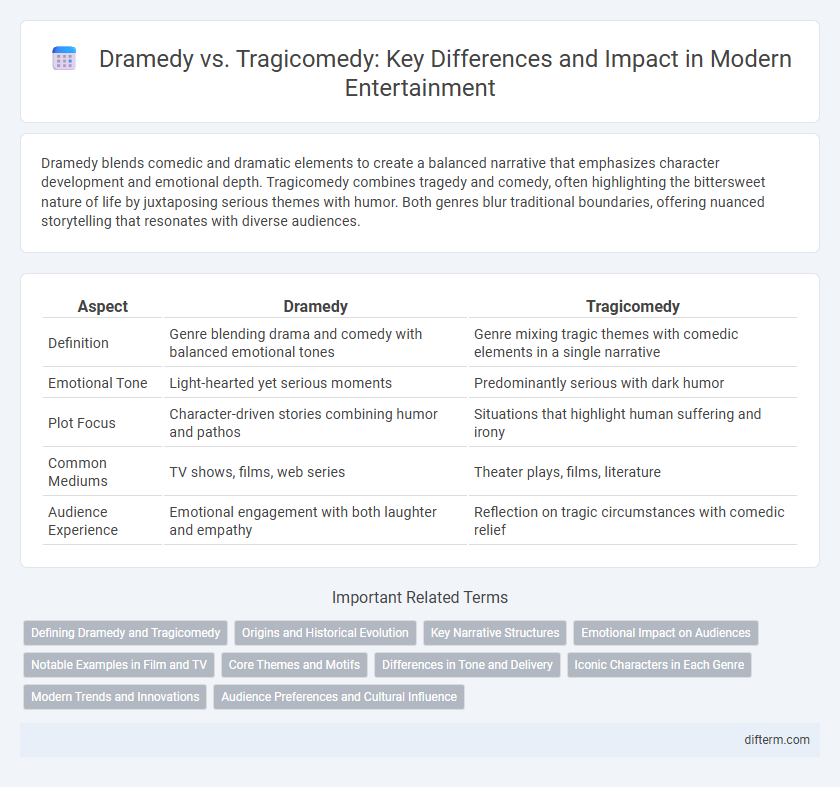Dramedy blends comedic and dramatic elements to create a balanced narrative that emphasizes character development and emotional depth. Tragicomedy combines tragedy and comedy, often highlighting the bittersweet nature of life by juxtaposing serious themes with humor. Both genres blur traditional boundaries, offering nuanced storytelling that resonates with diverse audiences.
Table of Comparison
| Aspect | Dramedy | Tragicomedy |
|---|---|---|
| Definition | Genre blending drama and comedy with balanced emotional tones | Genre mixing tragic themes with comedic elements in a single narrative |
| Emotional Tone | Light-hearted yet serious moments | Predominantly serious with dark humor |
| Plot Focus | Character-driven stories combining humor and pathos | Situations that highlight human suffering and irony |
| Common Mediums | TV shows, films, web series | Theater plays, films, literature |
| Audience Experience | Emotional engagement with both laughter and empathy | Reflection on tragic circumstances with comedic relief |
Defining Dramedy and Tragicomedy
Dramedy blends elements of drama and comedy, creating narratives that balance emotional depth with humor, often exploring real-life situations through a lighthearted yet poignant lens. Tragicomedy combines tragedy and comedy, presenting serious, often somber themes with humorous undertones, leading to complex storytelling where characters face profound conflicts amidst moments of levity. Both genres blur traditional boundaries, offering audiences multifaceted experiences that engage with the human condition beyond simple genre classifications.
Origins and Historical Evolution
Dramedy, a portmanteau of drama and comedy, originated in the late 20th century as a genre blending emotional depth with humor, evolving from television and film narratives aiming to portray realistic life complexities. Tragicomedy, with roots tracing back to ancient Greek and Roman theatre and later flourishing in Renaissance drama, combines elements of tragedy and comedy to explore human experience through contrasting tones. Both genres reflect cultural shifts in storytelling, with tragicomedy emphasizing nuanced moral dilemmas and dramedy focusing on relatable, contemporary scenarios.
Key Narrative Structures
Dramedy blends comedic and dramatic elements to create a balanced narrative that explores character development through humor and emotional depth, often featuring relatable life situations with a lighthearted tone. Tragicomedy combines tragedy and comedy by juxtaposing serious, often somber themes with ironic or absurd humor, using a plot that oscillates between moments of despair and laughter to highlight human complexity. Both genres utilize contrast in tone to engage audiences, but dramedy favors emotional resonance while tragicomedy emphasizes the coexistence of conflicting emotions within key narrative structures.
Emotional Impact on Audiences
Dramedy blends drama and comedy to create an emotional rollercoaster that balances laughter with heartfelt moments, making audiences feel both entertained and deeply connected. Tragicomedy, on the other hand, intertwines tragic themes with comedic relief, evoking a complex response where viewers experience sorrow alongside bittersweet humor. The emotional impact of dramedy tends to uplift by addressing real-life struggles with warmth, while tragicomedy often challenges audiences to confront pain through irony and dark humor.
Notable Examples in Film and TV
Dramedies such as "Gilmore Girls" and "The Marvelous Mrs. Maisel" blend humor with heartfelt storytelling, creating relatable characters and situations that balance lightheartedness with emotional depth. Tragicomedies like "Fargo" and "BoJack Horseman" incorporate darker themes and absurdity, juxtaposing humor with serious, often somber narratives to highlight complexities in human experiences. These genres leverage the interplay between laughter and pathos to engage audiences in multifaceted storylines, making them staples in contemporary film and television.
Core Themes and Motifs
Dramedy blends comedic elements with dramatic storytelling, focusing on relatable characters facing everyday challenges, emphasizing themes of personal growth, irony, and human resilience. Tragicomedy merges tragedy and comedy by portraying serious, often somber situations infused with humor, highlighting motifs of fate, existential conflict, and the paradox of life's absurdity. Both genres explore the complexity of human emotions, but dramedy leans toward hope and catharsis, whereas tragicomedy confronts bleak realities with a darkly comedic lens.
Differences in Tone and Delivery
Dramedy blends drama and comedy with a balanced tone, using humor to highlight emotional moments and maintain audience engagement without diminishing serious themes. Tragicomedy combines tragic and comic elements with a more ambiguous tone, often shifting between sorrow and humor to evoke complex emotional responses. The delivery in dramedy tends toward lightheartedness and relatability, while tragicomedy embraces irony and contrast to explore the profundity of human experience.
Iconic Characters in Each Genre
Iconic characters in dramedy often blend humor and emotional depth, like Lorelai Gilmore from "Gilmore Girls," who exhibits warmth and wit amidst life's challenges. In tragicomedy, figures such as Willy Loman from "Death of a Salesman" embody the tension between comedic absurdity and tragic despair, highlighting human vulnerability. These characters showcase the nuanced balance of tones defining their respective genres, resonating deeply with audiences.
Modern Trends and Innovations
Modern dramedy integrates realistic humor with emotional depth, reflecting contemporary life complexities through relatable characters and diverse storytelling techniques. Tragicomedy today blurs the lines between tragedy and comedy, often exploring existential themes with nuanced tone shifts that challenge audience expectations. Innovations in digital media platforms have amplified both genres, fostering experimental narratives and immersive viewer experiences.
Audience Preferences and Cultural Influence
Audience preferences for dramedy versus tragicomedy often reflect cultural nuances, with dramedies appealing to viewers seeking relatable humor blended with emotional depth, while tragicomedies resonate in societies valuing complex, bittersweet narratives. Cultural influence shapes how humor and tragedy are interwoven, affecting narrative pacing, character development, and thematic focus to align with local sensibilities. Streaming platforms and international film festivals highlight these distinctions by curating content tailored to regional tastes, influencing production and consumption trends globally.
Dramedy vs tragicomedy Infographic

 difterm.com
difterm.com